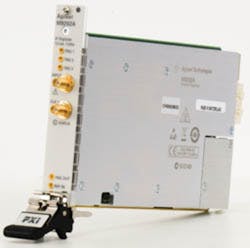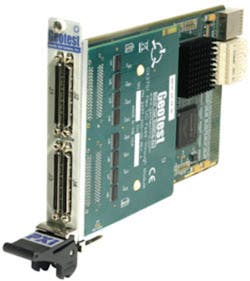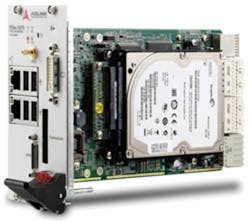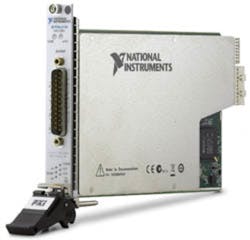Special Report: PXIe Extends PXI Appeal
Test systems having an optimum mix of PXI and PXIe modules are being designed by test engineers with support from equipment manufacturers. Nevertheless, the additional cost that often accompanies a PXIe module or chassis has highlighted the continuing relevance of PXI. Clearly, the requirements of a great many applications that were adequately addressed by PXI prior to the advent of PXIe have not changed.
Geotest-Marvin Test Systems has developed two 20-slot chassis for 3U PXI modules. The Model GX7305 is configured with a single-slot controller and additionally contains a hard disk drive, a DVD R/W drive, and rear-panel connections for Ethernet, USB, and VGA. The GX7315 uses an external controller and a PCI bus expander such as a MXI-4. Both chassis feature up to 60 W per slot, a 1,600-W power supply, four 100-cfm fans, and ample room for cable routing.
Of course, PXIe affords new opportunities because of its higher data transfer speed. However, functions such as switching typically require only a few control lines, and PXIe does not improve performance. One way that manufacturers have approached the co-location of both PXI and PXIe modules for a single application is by providing chassis with hybrid slots that accept either format.
The compatibility of PXI and PXIe modules has been facilitated by the design of the connector system. On a PXI module, the lower connector, J1, handles all the PCI bus signals, and the upper connector, J2, carries 64-bit PCI transfers, local bus signals, and triggering. For a PXI module to work in a PXIe hybrid slot, J2 is replaced by XJ4 that includes the same power, trigger bus, star trigger, and 10-MHz clock signals as originally on J2 but not the pins used for 64-bit transfers and the local bus.
If your PXI application makes use of the local bus, this scheme will not work. However, few applications have made full use of J2, so in most cases, the modification is straightforward. XJ4 is a different type of connector and about half the length of J2. That leaves room for XJ3, used on PXIe modules for differential triggers and clocks as well as PCIe lanes.
An unmodified PXI module cannot be plugged into a hybrid slot; however, many chassis provide a selection of PXI, PXIe, and hybrid slots. So, if only a few modules must retain their J2 local bus capabilities or for some other reason cannot be modified, such a chassis could be a solution. Depending on the model chosen, you may be limited to only three or four PXI slots. This type of chassis can work well but has inherent limitations on the number of PXI as well as PXIe modules that can be used.
Alternatively, all-hybrid chassis are becoming more prevalent. Actually, the term all-hybrid is not totally correct. A PXIe chassis accepts the system controller in the left-most slot as does a PXI chassis. However, a system timing controller often is needed and typically plugs in near the middle slot. The system timing and the system controller slots are distinguished by unique square and triangular glyphs, respectively. In an 18-slot PXIe chassis, for example, there could be as many as 16 hybrid slots. If a system timing controller is not needed, a PXIe peripheral module can be plugged into that slot.
Hybrid Chassis Applications
As discussed in detail in a 2010 EE-Evaluation Engineering article, a PXIe chassis is sophisticated. The very high data rate is achieved through multilane PCIe backplane buses. Both x8 and x4 links are available in Agilent Technologies’ Model M9018A 18-slot PXIe chassis, supporting either 4-GB/s or 2-GB/s per-slot bandwidth. Using a single x4 controller link provides greater compatibility among controllers but limits bandwidth.1
Courtesy of Agilent Technologies
According to Jean Manuel Dassonville, modular solutions outbound manager at Agilent Technologies, real-time data streaming is one of the applications that takes advantage of this high bandwidth. In an example comprising an M9392A Microwave Vector Signal Analyzer (VSA) and a 12-bit M9202A Digitizer (Figure 1), acquired data can be forwarded to a RAID controller through an M9021A PCIe Cable Interface Module. The digitizer’s 12-bit resolution and the VSA’s 100-MHz bandwidth combine to generate a data rate greater than can be accommodated by PCI.
PXIe chassis, such as the M9018A, also may support peer-to-peer data streaming via backplane switching. According to the company, “Any peripheral slot can communicate with any other peripheral slot without utilizing the system-slot PCIe links. The PCIe switches have a large crossbar capacity, allowing flexible placement of peer-to-peer modules without impacting data bandwidth.”
Catherine Wu, senior product director of ADLINK Technology’s Measurement Product Center, discussed the company’s most recently introduced chassis. “The new PXES-2590 PXI/PXIe Chassis provides nine all-hybrid peripheral slots for high data throughput and offers a flexible solution by allowing engineers to take advantage of both PXI and PXIe modules. Maximizing PXIe modules in the hybrid chassis gives a high-performance solution with throughput up to 8 GB/s and allows engineers to process high-bandwidth applications,” she explained.
“The PXES-2590 fan has a special placement that helps reduce its effect on sensitive modules,” Wu continued. “In addition, with the software-configurable ADLINK-automated monitoring system, the chassis monitors its own power and temperature, adjusting fans accordingly and triggering an alarm when user-configured limits are met.”
National Instruments’ (NI) Luke Schreier, senior group manager-automated test, described one of the semiconductor test applications that is using a hybrid chassis. “Triquint Semiconductor recently developed a PXI system that used both PXI and PXIe modules to reduce the time necessary to validate RF power amplifiers from two weeks to 24 hours. In the system, Triquint combined some of our latest technology for RF and digitizers that use PCIe as the communications bus, enabling fast data transfers alongside other modules like switches, power supplies, and source measure units based on the PCI bus inside the same hybrid-compatible PXIe system.”
Schreier concluded, “The advantage of buying a PXIe system today is that you benefit from both the latest advancements in the PC industry as well as maintain backward compatibility with the modules that have been on the market for the past 15 years. All NI PXIe chassis with four to 18 slots feature hybrid slots to support this common-use case.”
New Modules
Although currently the speed advantages of PXIe are being emphasized by many module vendors, conventional 3U and 6U PXI development continues. Geotest’s Mike Dewey, senior product marketing manager at the company, discussed recent work done with ThinKom Solutions. ThinKom has developed a series of MEMS-based phased-array planar antennas that are steerable in azimuth as well as inclination. Geotest became involved because 320 elements must be driven with independently programmed analog voltages from 0 to 20 V. An additional requirement was for 320 channels to be driven at either 0 or 20 V.
A new GX1642 64-channel 20-V DAC module was designed based on the existing 12-bit GX1648 with ±10-V output. Together with five GX1642 Modules and a GX1838-20 Module to provide +20 V, five GX6384-1 Dual 32×2 Switch Matrix Modules completed the solution. Dewey said that high speed was not a requirement, but a small form factor with a high channel count was key. The modules were configured as a test system to drive the antenna array inside a temperature chamber.
Courtesy of Geotest-Marvin Test Systems
For those applications that do require high-speed data transfer, Dewey referred to the GX3700e FPGA Module’s 800-MB/s data streaming rate, a direct result of basing the design on a x4 PXIe interface (Figure 2). The module includes a DMA controller and houses an Altera Stratix III FPGA that supports SerDes data rates to 1.2 Gb/s and digital I/O clock rates of 700 MHz.
ADLINK’s Wu provided details for three new designs: the PXI-9527 Dynamic Signal Acquisition Module for audio and mechanical systems, the much faster PXIe-9842 Digitizer for dynamic electrical measurements, and the PXIe-3975 Controller. Starting with the PXI-9527, 24-bit sigma-delta ADCs and DACs support two inputs and two outputs simultaneously sampled at up to 432 kS/s and 216 kS/s, respectively. This module includes IEPE circuitry that converts high-impedance piezo-ceramic transducer charge output into a low-impedance voltage signal.
The PXIe-9842 is a single-channel module with 14-bit resolution, 100-MHz bandwidth, and up to a 200-MS/s sampling rate. Wu commented, “The combination of a high sampling rate and high bandwidth allows you to record data continuously to computer memory or DMA to high-speed SSD to capture data for analysis. Target applications include radar signal acquisition, IF spectrum monitoring, physics experiments, and science research.”
Courtesy of ADLINK Technology
Energy efficiency has not been forgotten in the PXIe-3975 Embedded Controller based on an IntelR Core™ i5-520E 2.4-GHz Processor with hyper-threading and turbo boost technology (Figure 3). Wu added that “the controller also features up to 8 GB of 1,066-MHz DDR3 memory and a 160-GB, 7,200-rpm SATA hard drive for seamless execution in multitasking environments.”
NI’s Schreier highlighted the benefits of peer-to-peer data streaming in the company’s PXIe-5665 14-GHz VSA. “It takes advantage of multicore computing architectures and parallel programming capabilities through NI LabVIEW system design software. It also offers peer-to-peer data streaming for signal processing and a flexible MIMO architecture for phase-coherent measurements,” he explained. “Such features make it ideal for demanding RF test applications including RADAR, satellite, and radio and harmonic testing.”
Courtesy of National Instruments
The NI PXIe-4140/1 Source Measure Unit (SMU) Modules operate at up to a very useful 600 kS/s, but their main advantage is density (Figure 4). They provide four SMU channels per PXIe slot and up to 68 SMU channels per PXI chassis in a 4U rack height to simplify testing of high pin-count devices. Additionally, the NI PXIe-4141 features SourceAdapt technology that engineers can use to custom-tune the SMU output response to any given load to achieve maximum stability and minimum transient times.
Future Solutions
The limited board area available in a 3U module restricts the applications that can be addressed. This point is well understood and, in fact, has helped justify larger formats such as AXIe with up to 200 W per slot and 900-cm2 board area compared to 30 W and 160 cm2 for PXI. According to Agilent’s Dassonville, “AXIe offers a flexible scalable platform with longevity, modularity, and high performance and is based on the same software architecture as PXI.” Nevertheless, the importance of board area may have been overemphasized.
At least, that’s the opinion of NI’s Schreier who commented, “Ever since the introduction of PXI 15 years ago, doubters have described limits to what capability will be deployed in PXI based on power, size, cooling, etc., and every year vendors like NI, working with partners in the semiconductor industry that leverage Moore’s Law, reset the boundaries of that ‘conventional wisdom.’”
“2011 was a great example of this,” he continued, “where we introduced a 12.5 GS/s, 5-GHz digitizer; a four-channel SMU; a 14-GHz VSA; and a per-pin parametric measurement unit module for semiconductor test. All of these products at one point or another were called impossible to produce in a 3U PXI form factor.”
Geotest’s Dewey agreed, citing the higher power and cooling available in the company’s PXI chassis. He did comment, however, that “the size of RF components and the actual board space for 3U PXI/PXIe are as much a challenge as other technical aspects.”
Modular Implications
Agilent’s Dassonville expressed concern about interoperability, especially with regard to overall system characterization. “In theory, it is possible to build an instrument based on various modules coming from different vendors,” he said. “As every multimodule instrument is used to perform specific measurements, one of the key challenges is to understand the characteristics and specifications of this ‘new’ instrument. Even if the specifications of each module are well known, the calculation of the system’s performance is a challenging task.
“This is especially true for RF/microwave test systems,” Dassonville cautioned, “where all modules need to be designed together to ensure optimum performance. That’s why designers prefer solutions from a single vendor where the characterization has been done directly by the vendor.”
This comment relates to multimodule instruments such as NI’s PXIe-5665 VSA that comprises the NI PXIe-5605 Downconverter, the NI PXIe-5653 Local-Oscillator Synthesizer, and the NI PXIe-5622 150-MS/s IF Digitizer. Clearly, these modules must complement each other although each can be used by itself.
However, Dassonville’s comment more generally concerns an overall instrument function synthesized by an assembly of hardware and software modules—a synthetic instrument. In those cases where the user does not have access to the individual modules, a single manufacturer has total control of and responsibility for the system performance. To the user, the instrument’s synthetic nature may be undetectable.
Synthetic instruments that support user access to individual modules provide the advantage of easier hardware upgradability but against that require the user to be responsible for overall characterization if modules are changed. This isn’t a new problem for system integrators accustomed to mixing modules from multiple vendors. Nevertheless, it is an important aspect associated with the replacement of traditional instruments by synthetic ones.
Reference
Lecklider, T., “A PXI Chassis Is More Than a Box With Slots,” EE-Evaluation Engineering, October 2010, pp. 14-19.
For More Information
ADLINK Technology — www.rsleads.com/204ee-197
Agilent Technologies — www.rsleads.com/204ee-198




